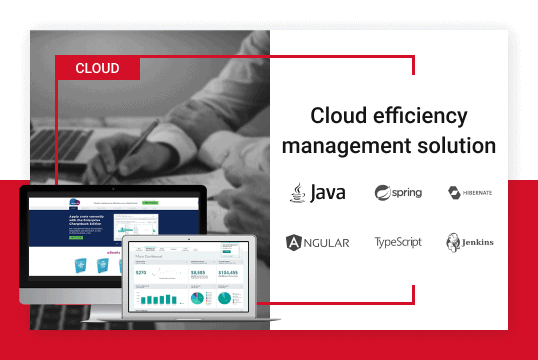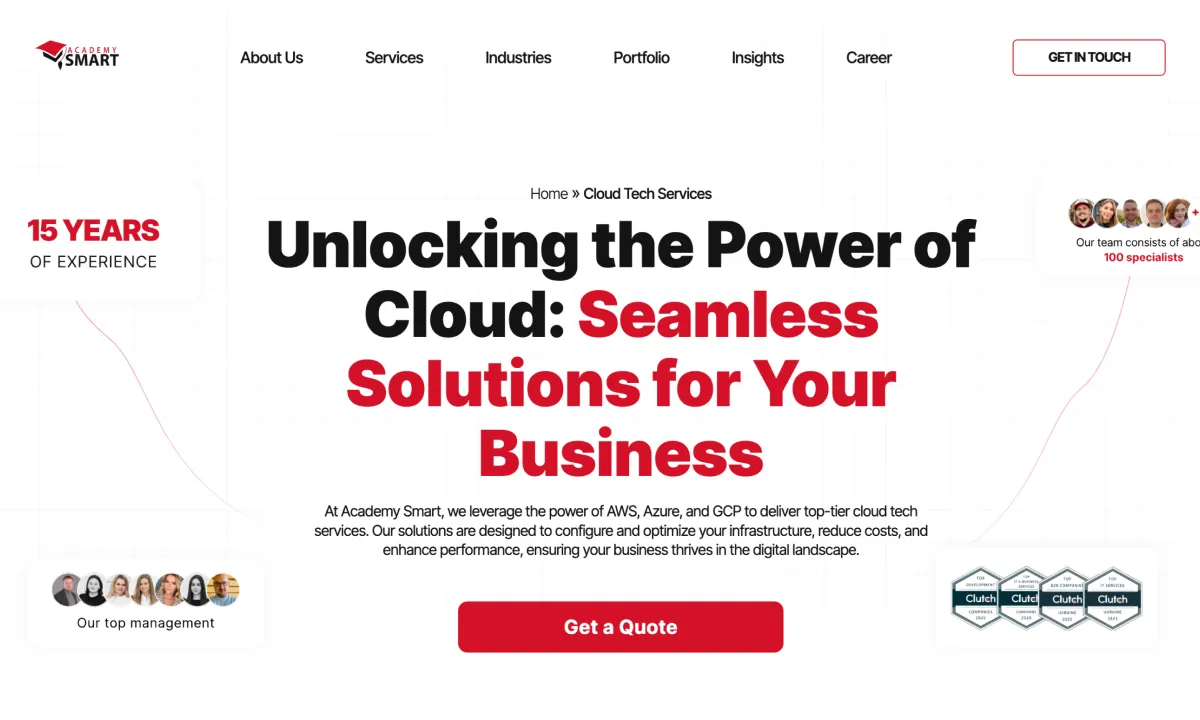
8 Benefits of Public Cloud Deployment Model
Contents
Since digital transformation reshapes industries, migrating business operations to the cloud has become a strategic direction for enterprises seeking agility, innovation, and reducing costs. The public cloud is a popular and effective solution for many areas of practical activity, offering a full range of managed public cloud services and high-speed deployment of infrastructure and applications. In this article, we’ll look at several noteworthy public cloud computing benefits that will give your business strategy a better chance of success.
What is Public Cloud
A public cloud is a prevalent cloud computing model where third-party providers leverage the internet to offer virtualized IT infrastructure, including servers, storage, and networking resources. In contrast to traditional on-premises setups, the public cloud eliminates the need for companies to purchase and manage their infrastructure. This model is characterized by a pay-as-you-go approach, allowing users to access services and scale resources on demand.
Unlike private clouds, where a single organization controls and maintains the underlying infrastructure, public clouds are multi-tenant environments. It means multiple users, or tenants, share the same physical hardware and network devices. Prominent public cloud providers, such as Amazon Web Services (AWS), Microsoft Azure, and Google Cloud Platform (GCP), own and operate vast networks of data centers globally, ensuring widespread accessibility.
Public cloud services encompass various offerings, from virtual machines and storage to applications, databases, and platform-as-a-service (PaaS) elements. Users can assemble these resources to construct a flexible, scalable infrastructure supporting various workloads.
In contrast to private clouds, where enterprises may face upfront infrastructure costs and limited scalability, public clouds excel in cost efficiency and rapid elasticity. Users benefit from the provider’s global reach, ensuring low-latency access for a diverse user base. However, it’s essential to consider those challenges like limited control over the infrastructure, potential compliance and legal risks, and cost concerns.
Examples of well-known public cloud providers include Amazon Elastic Compute Cloud (EC2), Microsoft Azure, Google AppEngine, and IBM’s Blue Cloud. The public cloud’s pay-as-you-go model and flexibility suit small and medium-sized businesses, non-sensitive web applications, and online scenarios with unpredictable traffic patterns.
What applications benefit highly from public cloud
Public cloud services are advantageous for various applications, offering businesses dynamic scalability and cost-effective solutions:
- Web applications and E-commerce platforms
Public cloud services are ideal for web applications and e-commerce platforms with varying workloads. These applications often experience fluctuating traffic, and the ability to dynamically scale resources up and down ensures optimal performance during peak periods without over-provisioning during quieter times. - Content delivery services
Applications that require global content delivery, such as streaming services or content-heavy websites, benefit from the extensive network infrastructure of public cloud providers. The distributed nature of public cloud data centers enables efficient content delivery to users worldwide, reducing latency and enhancing the user experience. - Development and testing environments
Public clouds offer on-demand resources, making them valuable for software development and testing activities. Development teams can quickly get virtual machines, storage, and other resources for testing new features or conducting quality assurance without requiring extensive on-premises infrastructure. - Big Data and analytic utilities
The ability to access and provision significant computational power on demand facilitates the efficient processing of large volumes of data, making it well-suited for analytics, machine learning, and data-intensive workloads. Integrated with distributed computing systems, public cloud usage elevates the performance and efficiency of these applications. - Collaborative tools and productivity suites
Applications that support collaboration and productivity, such as office suites and communication tools, benefit from the accessibility and scalability of public cloud services. Users can access these tools from anywhere, and companies can quickly scale resources based on user demand, making them suitable for small and large businesses. - Backup and disaster recovery tools
Public cloud services provide a robust solution for backup and disaster recovery scenarios. Businesses can securely store backup data in the cloud and quickly recover their systems and data in the event of a disaster. The pay-as-you-go model ensures cost efficiency, especially for businesses that don’t require constant access to recovery resources.
Academy Smart has developed many successful manufacturing and service applications based on the Amazon AWS and Microsoft Azure public clouds, which use various infrastructure components and advantages of this deployment model.
Advantages of Public Cloud for Business Apps
Public cloud computing offers eight key benefits to business organizations. Let’s explore them closer.
High availability and reliability
Public cloud providers, such as AWS and Azure, strategically position multiple data centers across various geographic regions. This global presence ensures high availability by minimizing the impact of potential disruptions. Redundancy and failover mechanisms are integral components, contributing to increased reliability. For instance, AWS offers services like Amazon S3 for object storage and Amazon RDS for managed databases, designed with redundancy features to ensure data availability despite hardware failures.
Public cloud providers invest heavily in infrastructure, ensuring users can access the latest hardware and software. Cloud vendors manage automatic updates, patches, and maintenance, reducing the burden on enterprises. That not only enhances security but also contributes to high availability. AWS provides services like Amazon EC2 Auto Scaling, and Azure offers Virtual Machine Scale Sets, allowing automatic adjustments to capacity based on demand, ensuring consistent performance and reliability.
Public cloud suppliers deliver high availability by offering resources that can be rapidly scaled up or down. AWS’s Amazon CloudFront, a content delivery network (CDN), and Azure’s Azure Traffic Manager, a global DNS load balancer, exemplify tools that distribute workloads and optimize user experiences by directing traffic to the most available and responsive servers.
With infrastructure maintenance handled by cloud providers, business and its development teams can focus on value-added activities. AWS Lambda and Azure Functions, both serverless computing platforms, allow developers to deploy applications without managing the underlying infrastructure, contributing to faster time-to-market for new products and services.
Global content delivery
Public cloud computing ensures seamless content delivery globally, optimizing user experiences and fostering a competitive edge. Public cloud providers, including AWS and Azure, guarantee more than 99% uptime, minimizing the risk of service failures. The interconnected nature of the cloud system ensures that the workload smoothly transitions to alternative servers in the event of a server failure, ensuring continuous performance for business-critical applications.
Integrated with public cloud platforms, Content Delivery Networks enhance the performance and reliability of content delivery to users worldwide. Amazon CloudFront and Azure CDN are designed to accelerate the delivery of web content, videos, and applications with low-latency access across diverse geographical locations.
Elastic scalability
A significant advantage of public cloud scalability lies in its responsiveness to changing needs and demands. AWS and Azure empower businesses to scale resources automatically and dynamically, adapting to evolving market conditions and user requirements. AWS Auto Scaling and Azure Autoscale are exemplary services that enable enterprises to adjust the number of compute resources automatically based on parameters like demand or traffic. This flexibility allows companies to remain agile and competitive, responding swiftly to workload fluctuations and optimizing resource utilization.
Public cloud users benefit from virtually unlimited scalability, with the capacity and resources rapidly expanding to meet varying demands and traffic spikes. AWS Global Accelerator and Azure Traffic Manager enhance redundancy and high availability across logically separated cloud locations. These services optimize connectivity between cloud services and end-users, addressing bandwidth and latency challenges for globally distributed applications.
Resource optimization
Public cloud platforms, such as AWS and Azure, enable dynamic allocation of resources. That ensures optimal performance without the need for over-provisioning. AWS Elastic Compute Cloud (EC2) and Azure Virtual Machines exemplify this capability, allowing clients to scale instances based on demand, ensuring that computational power aligns with actual workload requirements.
Through virtualization and resource pooling, public cloud environments facilitate their efficient utilization. AWS Elastic Load Balancing and Azure Load Balancer distribute workloads across multiple components, preventing bottlenecks and ensuring each one operates optimally. It eliminates the need for static instance assignment and promotes flexibility in resource assignment.
Managed services
Public cloud computing offers a variety of managed services, relieving users of the operational burden associated with traditional infrastructure management.
- Database services
Amazon RDS or DynamoDB, and Azure SQL Database or Cosmos DB provide managed database solutions, handling tasks such as backups, patching, and maintenance, allowing developers to focus on application logic rather than database administration. - Infrastructure management
Platform-as-a-Service (PaaS) like AWS Elastic Beanstalk or Azure App Service offerings simplify the deployment and management of applications, automating many tasks and allowing developers to focus on writing code. - Machine Learning services
Amazon SageMaker or Azure Machine Learning facilitates machine learning model development, training, and deployment, abstracting the underlying infrastructure complexity and enabling data scientists to concentrate on building and improving models. - Analytics services
Services like Amazon Redshift or Azure Synapse Analytics offer managed analytics platforms, allowing clients to process and analyze vast amounts of data without intricate infrastructure management. - DevOps and Agile workflows
AWS CodePipeline and AWS CodeDeploy, or Azure DevOps Services, simplify the software development lifecycle, providing continuous integration, delivery, and deployment tools. They contribute to adopting Agile processes reducing lead times in testing and deploying apps.
Security features
Public cloud computing offers robust security features, making it a protected environment for hosting data and applications. However, it’s important to note that AWS and Azure emphasize the shared responsibility model, where the cloud providers manage the security of the cloud, and customers handle security in the cloud.
Cloud vendors invest significantly in security measures, and examples of these features include:
- Data encryption
AWS Key Management Service and Azure Storage Service Encryption provide encryption mechanisms to protect sensitive data, ensuring confidentiality even if unauthorized access occurs. - Identity and Access Management
IAM services like Azure Active Directory or AWS Identity and Access Management help organizations control who can access their resources and what actions they can perform, enhancing overall security. - Compliance certifications
Compliance certifications ensure that cloud providers adhere to recognized standards, meeting the security requirements of diverse industries, for instance, HIPAA, PCI DSS, ISO 27001, GDPR, or FedRAMP. - Regular penetration testing
Regular testing helps ensure that the cloud infrastructure is resilient against potential security breaches, offering continuous improvement in security measures. - Cybersecurity expertise and innovation
Cloud providers exploit cybersecurity expertise to implement advanced security measures and offer tools that help monitor and respond to security threats. Cloud-native security services like AWS WAF or Azure Security Center utilize modern technology to provide real-time protection against evolving security threats. AWS Security Hub equips an exhaustive view of high-priority security alerts and compliance grades.
Automation and DevOps integration
Public cloud environments offer instant access to infrastructure and support automated workflows. AWS CodePipeline and Azure DevOps enable continuous integration and continuous delivery (CI/CD), reducing project delivery times for developers. This rapid and automated deployment of apps and updates enhances efficiency, allowing businesses to stay agile in the face of changing requirements. In addition, AWS CloudFormation and Azure Resource Manager provide infrastructure as code, allowing enterprises to automate deployment and management processes. That minimizes the need for a sizable on-premises staff, freeing IT professionals to focus on more strategic and revenue-generating activities.
Pay-as-You-Go model
Cloud migration transforms infrastructure spending from capital expenses (CapEx) to operating expenses (OpEx). Public cloud services typically assume a pay-as-you-go pricing model, allowing companies to pay only for the resources they consume. That eliminates the need for heavy upfront investments in hardware and infrastructure, which is crucial when adopting cloud computing services for start-ups and small businesses.
While service providers handle maintenance and software updates as fixed costs included in the subscription, it eliminates the need for clients to invest time and resources in performing upgrades, reducing overall support and related expenses. Moreover, the pay-as-you-go model eliminates wasted spending on unused resources.
Public clouds are more cost-effective than private clouds as they are shared among multiple customers. This shared cost structure allows service providers to spread infrastructure and maintenance costs across a broader customer base. In addition, enterprises can allocate their internal staff’s time to more strategic roles by offloading responsibilities to a public cloud provider. That contributes to increased efficiency and allows staff to focus on activities that grow the business.
Finally, specific cloud management applications allow you to finely tune the cloud operations and save significant money due to its optimization.

Cloud tuning application we developed
Open Benefits of Public Cloud Computing with Academy Smart
Our experts offer their proficiency in developing custom software applications to ensure the migration of your IT systems to the cloud. The adept team, comprising skilled programmers, AWS architects, cloud engineers, DevOps professionals, business analysts, and IT project managers, is available for hire to augment your workforce or form a dedicated team for seamless project delivery.
Get in touch whether you’re looking to customize a pre-built cloud application or develop new cloud-native business software. Our services will be useful.
Frequently Asked Questions: Public Cloud Benefits
Is AWS a public cloud?
Yes, Amazon Web Services is a public cloud platform offering businesses, individuals, and organizations a wide range of on-demand cloud computing services.
What are the benefits of moving workloads into the public cloud?
Moving workloads into the public cloud enables enterprises to focus on core business processes while leveraging flexible and advanced cloud capabilities.
Book a free consultation

Reach out to start talking today!













